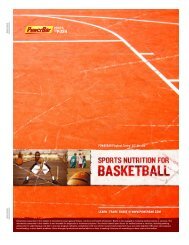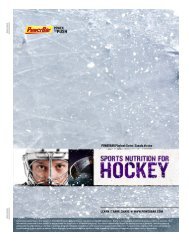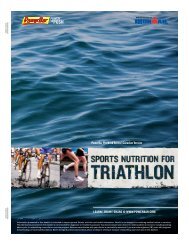sports nutrition for strength training - PowerBar.Com
sports nutrition for strength training - PowerBar.Com
sports nutrition for strength training - PowerBar.Com
Create successful ePaper yourself
Turn your PDF publications into a flip-book with our unique Google optimized e-Paper software.
<strong>PowerBar</strong> Playbook Series | Sports Nutrition For Strength Training<br />
<strong>PowerBar</strong> ® Per<strong>for</strong>mance<br />
Energy bar<br />
DON’T SKIP MEALS AND SNACKS<br />
Your muscle tissue is constantly being remodeled. Existing muscle<br />
proteins are being broken down, while new muscle proteins are<br />
being made. The breakdown process is called protein catabolism; the<br />
making of new muscle tissue proteins is called protein anabolism.<br />
At any given moment, the two processes are happening simultaneously<br />
in your muscles, but the rates of each are constantly changing.<br />
What you eat has a strong impact. For example, eating protein has a<br />
strong anabolic effect on your muscle tissue, whereas going without<br />
food overnight or <strong>for</strong> an extended period has a catabolic effect. So<br />
don’t skip breakfast or go <strong>for</strong> long periods without eating, especially<br />
be<strong>for</strong>e workouts, and make sure to consume some protein with each<br />
meal and snack. To maximize energy <strong>for</strong> your <strong>training</strong> session, aim<br />
<strong>for</strong> a snack 30–60 minutes be<strong>for</strong>e your workout. Also, carry snacks<br />
with you during the day so that you don’t have to go too long without<br />
eating or rely on less suitable options.<br />
PREWORKOUT SNACKS<br />
Fruit smoothie made with fruit and fat-free yogurt<br />
(8 fl oz/240 ml)<br />
Carbs<br />
47g<br />
Meal replacement beverage (8 fl oz/240 ml) 30–41g<br />
Low-fat or nonfat yogurt (6-oz/180-ml container)<br />
33g<br />
<strong>PowerBar</strong> ® Per<strong>for</strong>mance Energy bar 44–46g<br />
<strong>PowerBar</strong> ® Energy Bites<br />
<strong>PowerBar</strong> ® Energy Bites (1 pouch)<br />
<strong>PowerBar</strong> ® Energy Blasts gel filled chews (1 pouch)<br />
Ironman Per<strong>for</strong>m <strong>sports</strong> drink (20 fl oz/591 ml)<br />
26g<br />
45g<br />
42g<br />
<strong>PowerBar</strong> ProteinPlus ®<br />
30g protein bar<br />
TIME YOUR PROTEIN INTAKE around <strong>training</strong> AND PROVIDE A<br />
LEUCINE BOOST<br />
Strength <strong>training</strong> boosts the rate at which muscle tissue proteins are<br />
made, both during and after exercise. Although protein requirements<br />
vary between individuals, aim <strong>for</strong> 10–20 grams of protein as part of<br />
a carbohydrate/protein snack about an hour be<strong>for</strong>e your <strong>training</strong><br />
session, and aim <strong>for</strong> 15–25 grams of protein within 1 hour after exercise.<br />
This will help ensure that you have amino acid building blocks<br />
on hand to support the making of new muscle proteins. For muscle<br />
repair and building when glycogen restoration is not a priority, use<br />
<strong>PowerBar</strong> ProteinPlus protein powder drink mix to help build lean<br />
muscle. For more intense periods of <strong>strength</strong> <strong>training</strong>, take advantage<br />
of research indicating that the amino acid leucine directly stimulates<br />
For more in<strong>for</strong>mation and additional copies, go to: www.powerbar.com/playbooks<br />
10







